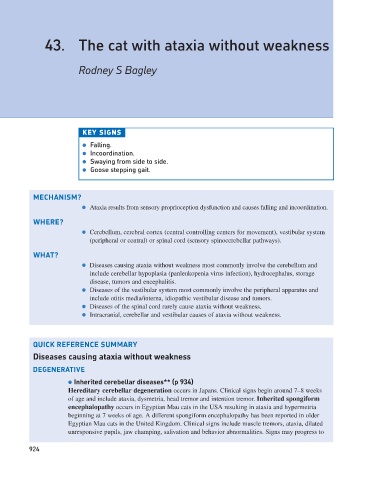Page 932 - Problem-Based Feline Medicine
P. 932
43. The cat with ataxia without weakness
Rodney S Bagley
KEY SIGNS
● Falling.
● Incoordination.
● Swaying from side to side.
● Goose stepping gait.
MECHANISM?
● Ataxia results from sensory proprioception dysfunction and causes falling and incoordination.
WHERE?
● Cerebellum, cerebral cortex (central controlling centers for movement), vestibular system
(peripheral or central) or spinal cord (sensory spinocerebellar pathways).
WHAT?
● Diseases causing ataxia without weakness most commonly involve the cerebellum and
include cerebellar hypoplasia (panleukopenia virus infection), hydrocephalus, storage
disease, tumors and encephalitis.
● Diseases of the vestibular system most commonly involve the peripheral apparatus and
include otitis media/interna, idiopathic vestibular disease and tumors.
● Diseases of the spinal cord rarely cause ataxia without weakness.
● Intracranial, cerebellar and vestibular causes of ataxia without weakness.
QUICK REFERENCE SUMMARY
Diseases causing ataxia without weakness
DEGENERATIVE
● Inherited cerebellar diseases** (p 934)
Hereditary cerebellar degeneration occurs in Japans. Clinical signs begin around 7–8 weeks
of age and include ataxia, dysmetria, head tremor and intention tremor. Inherited spongiform
encephalopathy occurs in Egyptian Mau cats in the USA resulting in ataxia and hypermetria
beginning at 7 weeks of age. A different spongiform encephalopathy has been reported in older
Egyptian Mau cats in the United Kingdom. Clinical signs include muscle tremors, ataxia, dilated
unresponsive pupils, jaw champing, salivation and behavior abnormalities. Signs may progress to
924

